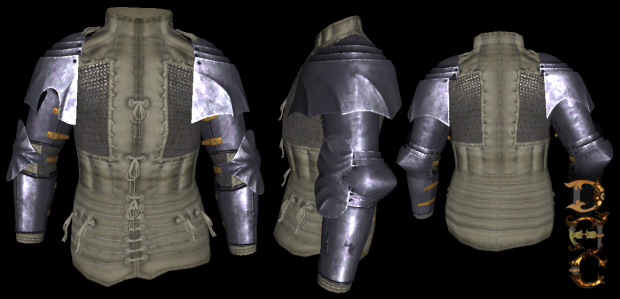Deeds of Arms and Chivalry is a modification for Mount & Blade: Warband which focuses on the Hundred Years War between France and England, specifically during the early 15th Century.
English Arm Harness Variants
(view original)
Post a comment
Description
English plate arm harness, 1440. The spaulders have evolved for the first time into asymmetrical pauldrons. The right pauldron is cut-out to allow a couched lance. The fluting seen on the pauldrons and couter wings predate the more iconic fluting of Gothic armor, by almost 30 years. The overall design is imposing yet graceful, yet fully functional.
Made by AsherNitin.







Now these are PAULDRONS!
Early pauldrons.
They say fluted armors are a way into a man's heart...
You're my favorite armor smith in France ;)
But Master_Rawl, I've never been to France. I'm Indian, born to Indian parents, raised in India, and living in India. :D
You're my favorite armor smith in F̶r̶a̶n̶c̶e̶ India :)
How did you find yourself so interested in medieval European arms and armor? Do you have models of Indian arms and armor somewhere as well? If so, I'd love to see them!
My progression is thus: gamer (interest in combat), then M&B (interest in medieval combat), then mods (for variety), first Floris (interest in variety of arms and armor), then 1257ad (actual exposure to historical period accuracy), then VC (further interest in slightly earlier period). VC and 1257ad showed me how armor and arms progressed in tandem, so that got me interested in how armor evolved.
Then as I played more mods, I quickly found that I disliked the aesthetic of more oriental armor, including Indian and Chinese armor. What made European armor so interesting is the degree of intelligence in the design. Europe sees more high-intensity high-casualty periods of warfare than other continents, despite a relatively lower population. So armor became highly optimized. In China, the scale of warfare was larger (large agrarian populations), in India it is sporadic and lower intensity, so their armors are less optimized.
So when I did study Indian and Chinese arms and armor, informally, ofc, I found myself unimpressed. They have a huge range of designs, with a narrow range of intelligent design, since the pressure to optimize was lacking. It might also have to do with both these regions having an intellectual class as their social elite (Brahmins, eunuchs/scholars/poets), instead of a warrior class, so the active interference of an emasculated profession in that of a masculine profession might have hindered it.
Good armor, like good science, involves everyone reaching a consensus, not multiple "schools of thought" led by individuals. Thus I find highly optimized narrow ranges of armor more interesting than wide ranges of fantastically shaped armor.
Note: pls remember what i say is contextually relative
This comment is currently awaiting admin approval, join now to view.